
Aalban, Principality of
by Michael BerryArea:
1,288 square miles
Population:
AC 1000 - 35,536
AC 1014 - 31,982
Towns: (population values are given for AC 1000 and AC 1014)
Leenz (4500/4000)
Graez (1300/1200)
Selected Villages: (population values are given for AC 1000 and AC 1014)
Ständburg: (1085/900): is on the Aalbanese side of Der Alte Bridge.
Fuhrburg: (925/800): is a large farming community at the centre of the Principality.
Ansburg: (800/700): is a village is halfway between Leenz and Ständburg.
Nachtruhe: (660/600): is west of Ständburg, where the famous Nacht Lagerbier is brewed.
Hügelsee: (560/500): is a village mainly populated by pure Hattians, it’s located near the northwestern border of the Principality.
Ritterburg: (470/400) is located next to Schloss Riterburg
Baylingen: (385/350): is a small fishing village West of Leenz.
Brändefort: (330/300): this old Flaemish fort borders with the County of High Sonden.
Ethnic groups:
Aalbanese 45% (mixed Hattian-Alphatian), Hattian 25%, Flaems 14%, Alphatian 10%, Averoignese 3%, Kaelics 2%, Other 1%
Languages:
Thyatian common (Hattian dialect), Alphatian
Ruler:
Prince Jaggar von Drachenfels, Count of Ritterburg, Viceroy of Fort Nordling, Warden of the Marches, Commander of Jaggar’s Division AC 1000-1005, Commander The Grand Army of Glantri AC 1005-1010, Commander of Glantrian 1st and 14th divisions AC 1010-1014.
Born 945, M30 (AC1000) M36 (AC 1006), Dragon Master of 5th Circle, AL-Lawful
House:
Ritterburg
AC 1000 - Voting Power: 16 at the Council, 32 at the Parliament
Allies: Lady Mariana Terlagand (M15), Marchioness of Berrym; Herr Rolf von Graustein (M14), Viscount of Blofeld; Herr Franz Lowenroth (M12), Baron of Adlerturm
AC 1014 – Voting Power 16 at the Council, 38 at the Parliament
Allies: Lady Mariana Terlagand (M19), Marchioness of Berrym; Herr Franz Lowenroth (M16), Count of Wylon; Herr Rolf von Graustein (M17), Viscount of Blofeld; Herr Josef Strantsky (M16), Baron of Brulefer
Family:
Frau Hildegard (mother): born AC 922, M15 (AC1000) M20 (AC1014), AL - Neutral
Frau Gertrud (wife): born AC 957, M12 (AC 1000) M14 (AC1010), AL - Neutral Deceased AC1010
Frau Helgar (sister): born AC 946, M8 (AC1000) M10 (AC 1014), AL - Neutral
Herr Sigmund (son): born AC 983, M8 (AC1000) M18 (AC1014), AL - Neutral
Herr Roderick (son): born AC 987, T5 (AC1000) T8 (AC 1014), AL - Chaotic
Military:
Prince Jaggar is a division commander in the Glantrian army and has the 2nd Banner of the elite 1st Division stationed in Leenz. The Banner patrols Aalban and the surrounding area in order to maintain law and order. Jaggar also maintains an elite bodyguard of 100 men in Ritterburg who are the Personal Guard of the Prince. Prince Jaggar also has the title of Warden of the Marches thus is considered the High Commander of the Glantrian Army. In the post Great War realignment and expansion of the Glantrian Army Prince Jaggar now commands a second Infantry Division, the experimental 14th. The two divisions would make up half of the Glantrian 2nd Army Corp when activated, under command of Prince Brannart while Prince Jaggar moved up to assume overall Grand Army command.
Jaggar's 1st and 14th Divisions (AC 1014):
Division Commander - 1st and 14th Divisions: Prince Jaggar von Drachenfels (M36)
Deputy Division Commander - 1st and 14th Divisions Herr Signund von Drachenfels (M18)
Brigadiers : 1st Div: Heinrich Kruger (M18) 14th Div: Hans Grüber (F15);
Head Mages- 1st Div: Frau Hildegard Von Drachenfels (M19, Earth Master 4th) 14th Div: Sir Maximilian Hiltier (M18)
Knights- 1st Div: Hans von Shtrout, Jaggar's personal guard (F20, two handed sword+3, golden plate armor+4, riding war horse) 14th Div: Frederick Steiner (F13, plate +3, Shield +4 of Haste, Longsword +4 , war horse)
Fighting troops: 860
Total (including officers, aids and logistics banner): 950
Headquarters: Fort Nordling
Peacetime Deployment - Protecting northern Glantri from bandits, and monsters coming down out of the mountains.
Jaggar's First Division is the best equipped and trained division in the Grand Army of Glantri. The 14th Division may perhaps, in time, come to be the equal of the First Division. However Prince Jaggar, being the military genius that he is, did what other the other commanders did not do and instead of creating a second division to match their 'first' division he created the 14th with a different mission and different organization. As such there are separate breakdowns for the two divisions of Prince Jaggar.
Jaggar's 1st Division: Jaggar's First is fully mounted, and as mentioned before, is the best equipped and trained division in the Grand Army of Glantri. Soldiers of Deca status and higher all have magical items (about 12%). Jaggar and Rolf have many constructs that they can add to the unit (stats not included). All officers of the First, even down to the Deca's, are combat veterans and experienced and capable commanders. The First has undergone extensive training in small unit, combined-arms tactics so while they still are organized in the Glantrian TOE in 4 Banners they actually can operate and deploy effectively on a smaller scale, or as a traditional force. Tactics are taught down to the lowliest foot soldier and personal initiative is rewarded not frowned upon even with the highly disciplined Hattian tradition. A highly motivated, and well trained force
1st banner- elite scout and shock company: 50 mounted commandos (F5) armed with short swords, daggers and leather armor+1 mounted on light riding horses; 50 mounted infiltrators (T5) short swords, nets, daggers +1 and leather armor+1 mounted on light riding horses; 20 battlemages (W5) staffs and daggers, mounted on light riding horses; 6 sergeants (4F6;2W6) ;2 Lieutenants (F8, M8); 1 captain (M10).
2nd Banner: 210 heavy foot(F3) with longswords, chain mail and large metal shields; 7 sergeants (F4); 2 Lieutenant (F6)
1 captain (F8). All equipped with riding horses for quick reaction on the battlefield and will dismount before fighting.
3rd Banner: 210 mounted archers (F2) with long bows, short swords and banded mail on riding horses; 7 sergeants (F4); 2 Lieutenants (F6), Captain (F8)
4th Banner (the Blitzkrieg battalion): 120 elite mounted mages (M5) armed with slings and staffs, riding warhorses; plus 4 sergeants (M7), 1 Lieutenant (M9); 180 heavy cavalries (F5) with lances, longswords, and full plate armour ; 6 sergeants (F6); 2 Lieutenant (F8); 1 Captain (M12)
The Blitzkrieg battalion is the perfect model of combined-arms in action. Tested and used to devastating effect in the war against Thar during the Great War. Basically the mages punch a hole in the enemy lines where the heavy cavalry can flow through to fan out in the enemies rear where they can then strike the enemy from behind or disrupt command and control or supplies. The banner can operate on it's own however the other banners are trained, from experience of working in conjunction with, and in support of, the 4th Banner
Jaggar's 14th Division
The 14th Division, though a line unit, is probably better thought of as a specialized support division. Thought of by Prince Jaggar to serve a particular need for troops trained in siege warfare, it is not normally meant to be deployed on it's own but in support of other units. The division trains rigorously in Ft. Nordling with Prince Jaggar in regular attendance.
1st Banner (der Pioniers) 120 pioniers (M3) armed with slings; plus 4 sergeants (M5), 2 Lieutenants (M7) and a captain (M10)
The soldiers of the 1st banner are selected for their knowledge and expertise in engineering. These mages are trained (and being cross-trained) in everything from overseeing the construction of defensive works to supervising the use of siege equipment. The banner has basic combat training and can serve as a basic combat mage unit but it's value is more for it's expertise rather than for pure one-on-one combat.
2nd Banner: 240 crossbowmen (F2) light crossbows, short swords, chain mail; 8 sergeants (F4); 2 Lieutenants (F6) 1 captain (F7)
specially trained banner in tactics for holding a besieged position.
3rd Banner: 240 medium foot (F2) pikes, short swords, shields, chain armour; 8 sergeants (F3); 2 Lieutenants (F5) 1 Captain (F7)
specially trained banner in urban warfare tactics.
4th Banner: same as 3rd banner
History:
The area between the Aalban River and the Black Mountains was first populated by Flaems, and owes its name to its first Flaemish Duke, Voortrije Aalban. The Duke ruled the valley stretching between the river and the mountains to the West from his seat in Aalbansford (modern Altendorf). In 801 AC, during the forty years war and after having pushed the Flaems to the other side of the river, Halzunthram gave the valley to his Hattian followers led by Sigmund von Drachenfels and gave him the title of Count of Ritterburg in exchange for the lands the Hattians had settled in the modern day Blackhill region. After the Alphatian leader was imprisoned, in 828 AC, Hattian leader Wilhelm von Drachenfels, who had earlier abandoned Halzunthram and joined the rebels, welcomed into the Hattian territories the Alphatians who had remained loyal to Halzunthram. Not surprisingly the region has since been plagued with internal fighting between the four factions living in the region: ‘pure’ Hattian and Alphatian families, the Flaems, and the naturally resulting mixed Hattian-Alphatians (Aalbanese) families.
Food:
Surplus food, exported throughout Glantri.
Trails:
The Aalban River is navigable to boat and ship traffic up to Leenz. Several bridges cross the river connecting the Principality with the Nordling Free Province and Berdghoven. The major ones are the Der Alte Brücke connecting Ständburg, on the Aalbanese side of the river, with Altendorf on Bergdhoven side; and the Drachen Brücke connecting Aalban and the Nordling Free Province by the Drachen (Dragon) road. Trails and roads within Aalban are very well kept. Fair to good trails connect every population center and extend to smaller settlements. Two trails lead west from Aalban.The most prominent is the fair trail connects Hirsberg, and its nearby mines in the BMFP, with Graez. A poor trail runs through the Black Mountains connecting the Principalities of Morlay-Malinbois and Aalban.
Economics:
Aalban produces a food surplus thanks to; advanced farming techniques, large amount of farming lands, and the use of swine as livestock. The mountains immediately surrounding Graez provide a large supply of iron, which is quite entirely crafted in the Principality. The mines are considered part of the Principality, instead of the Western Free Province, as they should. Cabbage, potatoes, and grain (beer) are exported, as well as swine by-products (mainly leather and pork). The greatest part of trade is held in the towns of Ständburg (where Aalbanese products are exchanged with Bergdhovese ones) and Leenz.
Aalban Monthly Financial Ledger (figures from AC1000)
Main resource: 1 animal (swine), 1 vegetable (cabbage/potatoes/grain/beer)
13 hexes: clear; rural; pop. 14560; tax 1456 dc
9 hexes: clear with river; rural; pop. 15120; tax 1512 dc
1 hex: mountain; borderland; pop. 56; tax 2.8 dc
Leenz: small town; pop. 4500; tax 1350 dc
Graez: village; pop. 1300; tax 130 dc
Total Population: 4500 town/suburban, 30980 village/rural, 56 borderland
Tax Income: 4,450.8 dc
Resource Income: 13,345 dc
Standard Income: 30,206.4 dc
Council Tax: 9,600.44 dc
Net Cash: 8195.36 dc
Overhead (60%): 4917.22 dc
Available Cash: 3278.14 dc
With 213550 XP/year (Limited to max 1 level gain per year solely for XP gained for dominion income), in 6 years Jaggar von Drachenfels could gain a maximum of 1,281,300 XP, rising from M30 to M36 in AC 1006!
Alternate: 53,409.6 XP/year, Jaggar rises from M30 to M34 by AC1010.
Cultural Curiosities:
FOOD
The Piazza Food Newwork is pleased to introduce our new food critic. You might remember his award winning culinary reviews for Glantri’s BETTER TOWERS AND GARDENS magazine: Micky the Mage. His first assignment for the PFN was to travel to all the principalities and report to us on the unique culinary treasures of the various cultures. His first stop was Aalban. So without further adieu… HERES….MICKY!!
Thanks Ed! You do need to lose that suit though man. Hey folks! I sure had one tasty time in Leenz, the Capital of Aalban. I was eating non-stop throughout the day since their food is very hard to resist, especially when accompanied with Aalbanese Nacht Lager! I took some pictures with my new spell ‘capture the moment’ (which will be available in scroll form at my booth at the next Arcanium for the low price of 10 Cr) of what I sampled when in Leenz.
The one below was taken at the Drachenfels Beer Garden on Einhandsegeln 69. Normally I do not like potato salad but this particular was superb as was the sausage. I could not get the recipe out of the owner but I really did enjoy it!
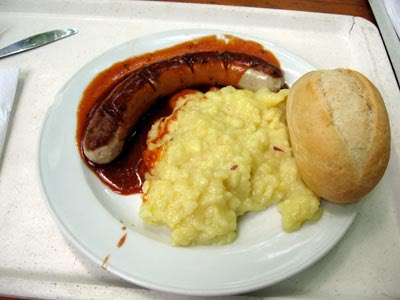
Another from the Drachenfels Bier Garden: Traditional mackerel in the Aalbanese way. I think the fish was a bit too dry and unseasoned myself. I have definitely had better fish dishes
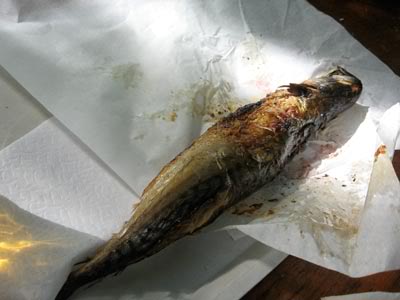
I made numberous stops in Leenz and was rather unimpressed overall with the food, though the Lager kept flowing and kept my spirits up. My patience and resolve were rewarded though in my final stop. A wonderful eatery, Die Flitzerkacke located on Hotzenstraße 11. I found the pork impeccably seasoned, the gravy tickled your tastebuds, and the house wine especially high quality. I would give Die Flitzerkacke 4 stars and was the best eatery I found in Leenz.
Pork fillet with a sausage and potatoes
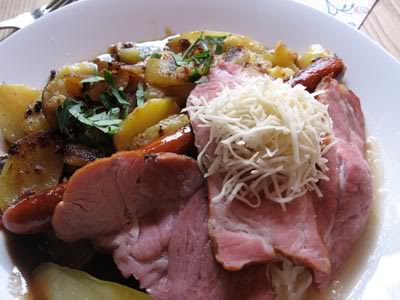
Pork with gravy, pork skin and potato stuffed with a sausage
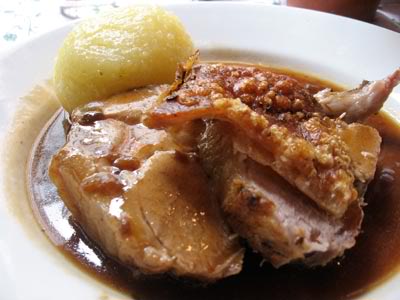
ARTS AND LITERATURE
The great Aalbanese contribution to the Glantrian arts would have to be the Opera. Opera incorporates many of the elements of spoken theatre, such as acting, scenery and costumes and sometimes includes dance. The performance is typically given in an opera house of which Aalban has the highest number, accompanied by an orchestra or smaller musical ensemble. The Hattians are mad for Opera and the openings of a new Opera are always sell outs. The Hattians have contributed many works of military literature to Glantri’s literary tradition. They include military studies of past wars, Glantrian and foreign, biographies of great leaders, and modern essays on the Glantrian military and foreign military.
ARCHITECTURE
The Aalban Rococo style is distinct to the rest of Glantri. This ornate and “pretty” style began becoming popular in Aalban in the 9th century with the creations of Heinrich Bavaria and was a fertilization of Hattian and Alphatian traditional designs. The buildings can often be found with a pastel pink or blue color, and gold trimmed wood and other carvings. Rococo, also known as Bavarian, lends itself to a more rounded and softer look.
SPECIAL CUSTOMS
The Aalbanese place a high priority on structure, privacy and punctuality. They embrace the values of thriftiness, hard work and industriousness. There is great emphasis on making sure that everything runs on time. The Aalbanese are stoic people who strive for perfectionism and precision in all aspects of their lives. They do not admit faults, even jokingly, and rarely hand out compliments. At first their attitude may seem unfriendly, but there is a keen sense of community and social conscience and a desire to belong. Which has been strengthened over the years by the inherent difficulties of having such disparate and adverse cultures together with Hattians, Alphatians and Flaems all living in close proximity in most areas of Aalban. Aalban has several holidays and festivals that exemplify some of this traits found here.
Tag der Arbeit: (1 Yarthmont) is the national holiday of the Aalbanese where no work is done and the Principality for one day a year loses itself in revelry (often drunken) and celebration of the hard working and industrious Aalbanese working class.
Tag der Aalban Einheit: (5 Klarmont) is Aalbanese Unity Day in which festivals are held all over Aalban celebrating both the ancient Hattian and Alpatian cultures as well as their joining to form a new Aalbanese culture.
Volkstrauertag: (1 Eirmont) is held the same day as Klantyre’s Necromantia and is a day in which the Aalbanese honor soldiers who died honorably in battle. In some areas of Aalban, the predominantly Hattian areas, it is a day of silence in that music or dance are strictly prohibited.
Notable sites:
Leenz
Ruler: Burgemeister Leopold von Drachenfels (born 965, F7, AL- L), Leopold is the second cousin of Prince Jaggar. The Burgmeister is the Head of Leenz deployment of Aalban Armed Militia, and is appointed by the Prince of Aalban. Leenz is the Northwestern Glantri’s most populous settlement and starting point of the caravans directed to the Capital with the bounties of of the Aalban River valley and surrounding mountains.
Drachen Zentral is Aalbanese University of Monster Lore and Hunting. Courses are opened to students of every principality, but Aalbanese students generally average 50% of the student population. Averoignans and Flaems make up a majority of the remaining 50%, with small percentages of Alphatian, Boldavian, Caurenzan and Kaelic students. The University, in fact, acts, as (Leenz’s only legal) Guards Employment Exchange: every day merchants ask for its services, paying them directly to the University. Students are paid via tuition credits for volunteering. The University earnings, some 500 gp every month, become part of Aalbanese treasury, after having paid its 50 full-time employees. Since the University holds some 500 students, it’s very severe in evaluating them: every year a student has to pass at least 7 courses, failing for two years in a row means the definitive failure of the student. The University keeps close ties with the Syndicates of Monster Hunters, that holds an office in the University. Drachen Zentral provides its students with the following basic courses: Animal Handling, Animal Lore, Direction Sense, Fire-building, Fishing, Hunting, Monster Lore, Rope use, Set Snares, Survival, Swimming, Tracking.
The Noble Quarter in Leenz is surrounded by a natural park with the Great Temple of Rad at its very center. A famous promenade, the Magiengasse, hosts the headquarters and residence for authorities and nobles. Krema’s Mansion, the private residence of Krema family, is the wonderful palace where Gertrud Krema, aka von Drachenfels, wife of Prince Jaggar, holds the secret meetings of the Free Anachronistic Society of Aalban. The Palace stands apart from the rest of the Quarters, and was commissioned by Aens Krema, a very rich Hattian-Alphatian mage. It has 336 windows, a different view for every day of the year. The Port Quarter is safe and clean. The area is heavily patrolled and many cargoes are daily shipped downriver. Passages cost 2 sovereign per miles for first-class passages and 5 pennies per mile for second class passages. Third class passages aren’t provided.
Graez
Ruler: Burgemeister Albrecht von Drachenfels (born 954, M7, Al L), cousin of Prince Jaggar’s father, Morgaithe. The Burgmeister is the Head of Graez regiment of the Aalban Armed Militia and is appointed by the Prince of Aalban. Graez’s isolation from major trails made it the safe haven for those who didn’t want to deal with strangers, and those no of pure Hattian decent. It’s considered unsafe for a non-Hattian, and especially for Alphatians, to enter the town, since the militia itself recognizes how little it can do to protect the unlucky. Graez is the greatest stronghold of pure Hattians families. Miners, artisans working raw iron, and few merchants and petty nobles make the majority of the population. A local brewery produces enough ale, Hochwertig Lager, to satisfy the town’s demand. Iron and by-products are exported everywhere in Aalban.
The Iron Mines trace their first pound of ore extracted to the time of Flaems settlers, some 600 years ago. Lacking the necessary care, the mines collapsed and were closed more than once until the arrival of Aalbanese technology. Nonetheless, in 950, the extraction of ore drastically decreased because it was practically impossible at those depths, even for Aalbanese advanced technologies. Magic enabled Aalbanese industries to struggle for survival, but the great amount of ore had to be imported. Fortunately, prospectors appointed by the Prince found new veins and Aalbanese technicians provided a new mean to extract the ore to greater depths. However, the sophisticated machinery has recently been sabotaged, probably by rebels living in the Western FP, causing the collapse of one of the mines. Since then the safer mean of extraction has proved to be the "classical" partly magic- partly mechanic one. Aalbanese learnt the lesson since the amount of ore extracted has been wisely kept to that strictly necessary to Aalbanese machinery business, and escorted prospectors endlessly search the mountains for new veins of iron. The mines are guarded by a force of some 200 men of the Aalban Armed Militia, under the command of Graez Burgmeister. There are some 1000 workers and auxiliaries in the zone.
Ständburg
Ständburg is a large mercantile village on the Aalbanese side of Der Alte Bridge. Der Alte Bridge is the bridge connecting the Principalities of Aalban and Bergdhoven, 350 yard long and supported by 16 arches. Built shortly after the Light of Rad proclamation, by Friedrich von Drachenfels, first Prince of Aalban, who strongly wished to see the two Principalities connected through stable means. The bridge is heavily garrisoned and a toll is collected whenever entering one of the two Principalities. Merchants regularly crossing the bridge are allowed to pay an annual fee, which is substantially discounted to encourage trade. The main feature of the bridge is the possibility to move upward part of it, allowing the passage of large ships. The bridge was recently attacked and damaged by rebels, later found to have come from the Black Mountains, Prince Jaggar mounted an expedition soon after and put all the rebels, both known and suspected, to the sword.
Ritterburg
Ritterburg is Prince Jaggar’s Residence. A wonderful Castle, built during the first years of 9th century, its population amounts to 470 inhabitants, plus an undetermined number of magical constructs provided by the recent tireless work of Herr Doktor, Viscount Rolf von Graustein. Commissioned by Sigmund von Drachenfels, his heirs continue to improve it (it is said its walls are impregnable thanks to countless enchantments cast during the years) and to augment its size. It now contains some 100 rooms, two spacious courtyards, and the aquatic gardens. Every corner of the Palace is a little masterpiece: the Konzertsaal, renowned for its excellent acoustics, the Arbeitszimmer (Study), the Ungeheuer Museum (Monsters Museum), the Gallery with a collection of masterpieces coming from the whole Known World, the Throne Room, the White Hall dedicated to Joachim von Drachenfels (who adopted the white colors of peace for his family), the Prince's Chamber, adorned by portraits and sculptures of the past leaders of the von Drachenfels family, the Ratszimmer (Councilors’ Room) where Jaggar decides House Ritterburg politics with his most trusted allies, perhaps the most magnificent hall of Schloss Ritterburg. Springs from the mountains (and a little portal to the Elemental Plane of Water) feed the aquatic gardens. Billeted at Ritterburg are the 100 men of the personal Guard of the Prince. This highly trained and efficient unit is famous throughout Glantri. It is as well trained in ceremonial maneuvers as in proper battle, and have shiny white uniforms. Jaggar takes the time to get to know each and every guard by his name and gives them a feeling of supreme importance.
Their stats are: 100 elite fighters (F5, long sword +1, plate armor+1 covered with white fabric, shield, dagger)
5 indoor family guards (F7 sabre+1, dagger+1) all led by Hans von Shtrout, Jaggar's personal guard (F29, two handed sword+3, golden plate armor+4).
Additional weapons: the basements of Ritterburg tower are filled with fine weapons (some of them magical) that can equip several dozen men. The roofs of the tower are fortified with iron and magic. The tower mundane defences are augmented by combat magic's cast by Jaggar and his family and mages. Artillery consists of 1 heavy catapult and 10 different mechanical contraptions that have stats ranging from light ballistae to a heavy catapult.
Fuhrburg
Fuhrburg Military Academy is where Aalbanese draftees learn about the first rudiments of the military discipline, and where Aalbanese would-be graduates learn how to enforce it (with grumpy raucous voice). The Academy has recently been opened to non-Aalbanese would-be graduates. Already representing the safest and easiest career for sons of Aalbanese graduates, in few years, it has become the best alternative to young nobles and petty nobles’ heirs without any magical prowess, too. Tuition is very expensive, and the Academy does provide a great amount of ducats for the Aalbanese treasury (some 1000 dc/month). Located near the village of Fuhrburg, it usually is hosts some 200 soldiers at any one time.
Nachtruhe
Nachtruhe is the main brewing centre of the Principality. The most famous and drunk Ale produced is the Nacht Lager. The majority of Aalbanese people hold its strong taste and raw flavour in the highest regard. Its name derives from its crystalline yellow colour, which is told to glimmer in the darkest night thanks to some low-level secret enchantment used in its brewing
Coat of Arms:
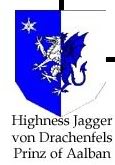
Useful links:
Glantrian Political History 828-884 - Harri Mäki and Giovanni Porpora
The Economy of Aalban by Aleksei Andrievski
History of House Ritterburg, by Harri Maki.
The Principality of Aalban by Thibault Sarlat, Giovanni Porpora, and Agathokles.
Glantrian Heraldry by Chimpman
The Grand Army of Glantri AC 1000-1014 by Michael Berry